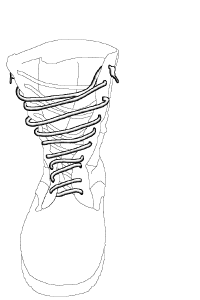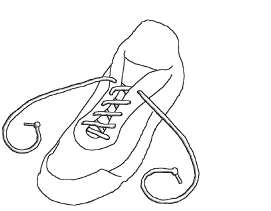Double Helix Shoe Lacing Process

I developed an innovative method for lacing shoes and boots. It makes shoes and boots faster and easier to tighten and loosen. The method works with any type of laces and any shoes or boots with standard lace-holes, such as a typical sneaker or the U.S. military's formerly-so-called Vietnam jungle boot, as illustrated in the drawings below, or the military's current safety boot or extreme cold weather boot; however, it does not work with boots or shoes employing a "speed lace system,” such as the military's current hot weather combat boot.
I developed the method at a time when I was using boots as illustrated below for caving, which often involved tightening or loosening laces that were thoroughly wet and/or caked with mud. The principle of the method is to eliminate the friction caused by laces crossing over each other. In achieving this goal, the method also results in laces that are significantly easier and faster to loosen and tighten because pairs of adjacent laces are pulled in the same direction.
The paths followed by the laces describe a double helix, like DNA or zDNA, as shown in the background of this webpage.
The method involves beginning lacing the shoe or boot through the lowest pair of lace-holes in such a manner that the lace ends are pointed in opposite directions relative to the upper surface of the shoe or boot, and continuing the lacing through the other lace-holes by inserting the lace end that is on the bottom through the bottom of the next-highest lace-hole on the opposite side, and inserting the lace end that is on the top through the top of the next-highest lace-hole on the opposite side (except with the top-most lace-holes, where it is more convenient to have both laces on the top).
I filed a patent application on 7/28/01, received a rejection a/k/a "Office Action," submitted my response, received a "Notice of Allowance," and finally Patent No. 6,513,211 issued on 2/4/03.

|

|
|
Click HERE to see individual boot drawings |
Click HERE to see individual shoe drawings |
|
Click HERE to see standard lacing methods  |
|